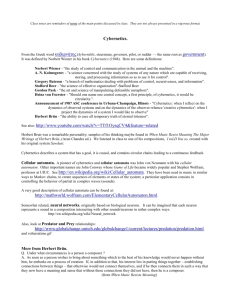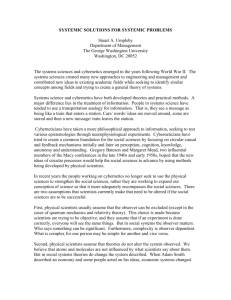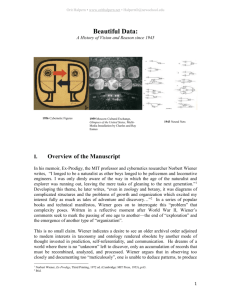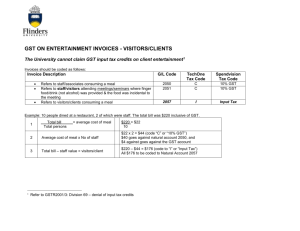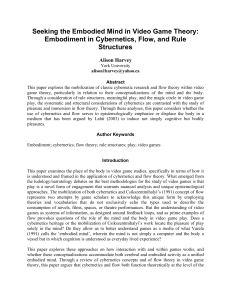Teaching Note Systems Theory and Management
advertisement
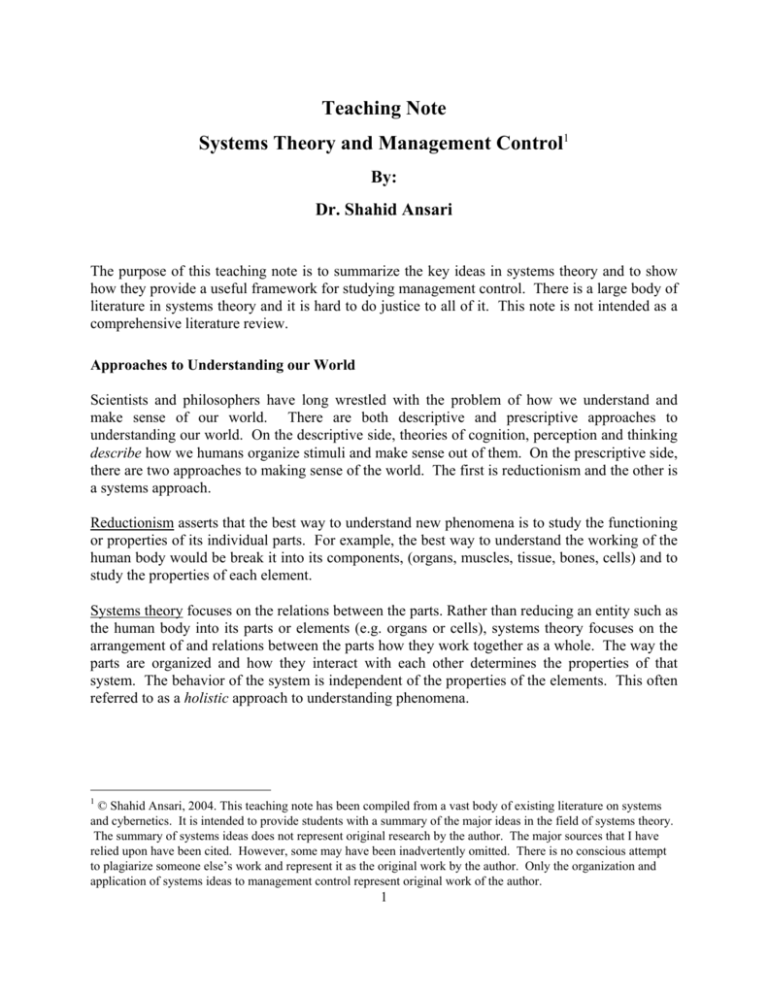
Teaching Note Systems Theory and Management Control1 By: Dr. Shahid Ansari The purpose of this teaching note is to summarize the key ideas in systems theory and to show how they provide a useful framework for studying management control. There is a large body of literature in systems theory and it is hard to do justice to all of it. This note is not intended as a comprehensive literature review. Approaches to Understanding our World Scientists and philosophers have long wrestled with the problem of how we understand and make sense of our world. There are both descriptive and prescriptive approaches to understanding our world. On the descriptive side, theories of cognition, perception and thinking describe how we humans organize stimuli and make sense out of them. On the prescriptive side, there are two approaches to making sense of the world. The first is reductionism and the other is a systems approach. Reductionism asserts that the best way to understand new phenomena is to study the functioning or properties of its individual parts. For example, the best way to understand the working of the human body would be break it into its components, (organs, muscles, tissue, bones, cells) and to study the properties of each element. Systems theory focuses on the relations between the parts. Rather than reducing an entity such as the human body into its parts or elements (e.g. organs or cells), systems theory focuses on the arrangement of and relations between the parts how they work together as a whole. The way the parts are organized and how they interact with each other determines the properties of that system. The behavior of the system is independent of the properties of the elements. This often referred to as a holistic approach to understanding phenomena. 1 © Shahid Ansari, 2004. This teaching note has been compiled from a vast body of existing literature on systems and cybernetics. It is intended to provide students with a summary of the major ideas in the field of systems theory. The summary of systems ideas does not represent original research by the author. The major sources that I have relied upon have been cited. However, some may have been inadvertently omitted. There is no conscious attempt to plagiarize someone else’s work and represent it as the original work by the author. Only the organization and application of systems ideas to management control represent original work of the author. 1 What is Systems Theory? A popular website on systems theory (http://pespmc1.vub.ac.be/SYSTHEOR.html) provides the following definition of systems theory: Systems Theory: the transdisciplinary study of the abstract organization of phenomena, independent of their substance, type, or spatial or temporal scale of existence. It investigates both the principles common to all complex entities, and the (usually mathematical) models which can be used to describe them. The word “transdisciplinary” explains why systems theory is so popular in many disciplines. It is because systems theory provides a meta-language to address a problem regardless of discipline. This common framework or language to address problems in fields as diverse as engineering, biology, organization theory, sociology, and psychology is what gives systems theory its near universal appeal. Two Versions of Systems Theory Systems theory has a long history in the realm of human knowledge. Some scholars trace the development of systems theory back to Aristotle. Most scholars attribute the idea of holism, central to systems thinking, to the German philosopher Hegel who stated that the whole was greater than the sum of its part. This idea that systems consist of a number of interrelated and interconnected parts, that once put together, make the behavior of the whole different and distinct than the behavior of its individual parts. Holism asserts that we cannot understand the behavior of the whole by studying the behavior of its various components. There are two versions of systems theory. The first, called closed systems came out of classical physics. Norbert Wiener and Ross Ashby developed its modern version called cybernetics. The other called open systems approach comes from biology. It was proposed in the 1940's by the biologist Ludwig von Bertalanaffy. Cybernetics and Closed Systems Thinking Closed systems thinking originated in classical (Newtonian) physics. Newtonian physics deals with relatively few variables. System elements (e.g. planets) behave with clockwork precision and return to original stable states of equilibrium. Small errors can be tolerated since they can be corrected before they have a significant impact on the system. The field of cybernetics exemplifies the modern version of closed systems thinking and it is attributed to the work of Norbert Wiener. In 1949, Norbert Wiener, a distinguished mathematician and engineer at MIT was having lunch with a colleague who was a neurosurgeon. Wiener was working on problems of electrical feedback of the kind that plague sound systems. His colleague, the neurosurgeon was working on a neural dysfunction that caused patients not be able to judge the distance of objects correctly. These patients, when trying to pick up a glass of water in front of them, might over reach or under reach the glass. 2 As the two scientists talked, they discovered that their respective problems were not quite as different as they had first thought them to be. The kind of electrical feedback that plagues sound systems was also responsible for the neural muscular disorder. The patients apparently were receiving electrical feedback from the brain that was causing the muscular dysfunction. The discovery that both the electrical engineering problem and the neural disorder problem had commonalties led to the search for a common language that might be used to describe both problems. The answer was systems theory. The modern closed systems approach was born with the publication of Norbert Wiener’s book on Cybernetics.2 The development of the field of Cybernetics allowed diverse disciplines to communicate about their problem in the common language of systems theory. More important, it allowed a common set of principles to be applied to problems of control and regulation. We began to see that the principles of system design that allowed ancient mariners to steer ships with “governors”3 were the same principles that allowed mechanical engineers to design thermostats for air-conditioning units, industrial engineers to control product quality, astronomers to describe the behavior of planets, and accountants to design budgetary control systems. We spoke of these systems as returning to equilibrium after being disturbed by regulating themselves through feedback information. Figure 1 A Typical Cybernetic Systems Model P u rp o s e o f C o n tro l D is t u r b a n c e s ( C o ld a ir ) Feedback Loop B u ffe rs ( W a lls ) C o n t r o lle d V a r ia b le ( R o o m T e m p .) In f o r m a t io n o n R o o m T e m p e ra tu re R e g u la t o r y M e c h a n is m ( S w it c h ) Figure 1 represents a typical schematic diagram for a cybernetic system using a heater’s thermostat as an example. The system returns to some desired stable state after disturbances have pierced the buffers. In our example, the room temperature is the controlled variable, cold air is the disturbance, and walls are buffers designed to keep temperature at desired levels. To control temperature, a switch (regulatory mechanism) turns the heat on when the thermometer provides the feedback information that the room is too cold (say less than 650). The idea that control or regulation occurs only after action has occurred is central to the cybernetic mode of thinking. This form of regulation is called “error-controlled regulation” in cybernetic terminology and the system is called a closed loop system. Its major property is that it operates on the basis of information about small errors to prevent large errors. 2 See Wiener, Norbert, Cybernetics: Control and Communication In The Animal And The Machine Governors were steering mechanisms to keep ships on course. The were called “kybernitke” in Greek which is the derivative for the word ”cybernetics.” 3 3 You may have noted the schematic diagram in Figure 1 can be used to describe traditional cost control or quality control approaches. Cost is budgeted and incurred first. We try to buffer costs from disturbances. When deviations from budgets (variances) occur, we use them as feedback information to take corrective action. Workers manufacture a product; inspectors check quality later. Using small samples, they look at defect rates to correct quality problems. The key idea is that action occurs first and regulation occurs later. The cybernetic closed systems model is the intellectual base for traditional cost and quality management approaches. Another key idea in closed systems is the increase in entropy or the tendency to maximum disorder. This is because the system is closed to the environment and has no ability to import energy to counteract the growth in entropy. This view, exemplified by the second law of thermodynamics, means that closed systems will inevitably tend to breakdown from an increase in entropy. Biology and Open Systems Thinking Open systems theory has its foundations in biology, particularly Darwin's work on the evolution of the species. The popular version of open systems theory is attributed to Ludwig von Bertalanffy who used the term general systems theory to describe the main ideas and to distinguish them from closed systems thinking. Bertalannfy maintained that closed systems thinking was not appropriate to study biological phenomena because biological systems interact with their environment, grow and survive. Error-controlled regulation, as depicted in Figure 1, works in stable and benign environments. However, the environment of living organisms is less forgiving and often the luxury to learn from errors does not exist. There are four main differences between closed and open systems theory. Each difference is discussed below. 1. Relations with the external environment. Open systems theory focuses on the interchange between a system and its environment. Biological organisms are open systems because they constantly evolve and adapt to the needs of their environment. Their behavior is a response to the threats and resources available in the environment in which they exist. 2. Variables considered. A second area, which differentiates open and closed systems thinking, is the number of variables included. A closed system has a few variables. An open system typically deals with a more complex set of interrelationships. Cost and quality, viewed from a closed systems perspective, are internal variables that need to be managed within the boundaries of a firm. In an open system, cost and quality are viewed as externally driven variables that must be managed by understanding the environmental influences on these variables. 3. Form of regulation or control. As shown in Figure 1, closed systems use error-controlled regulation. This is control after-the-fact. Open systems use anticipatory control. They regulate by anticipating errors before they occur and taking corrective measures before final output. Like a mouse, open systems anticipate a cat’s next move. Waiting for feedback from errors is usually fatal. This form of regulation is called feedforward control. If cost is to be managed as an open system, it should be controlled before a product is produced and not after. 4 4. Purpose of Regulation. Unlike closed systems, open systems are not interested in returning a system back to some predetermined stable state. They recognize that the purpose of regulation is to adjust and move the system on a dynamic path. Open systems seek continuous improvement and not just stability. They are said to achieve a dynamic equilibrium. Like living systems, most organizations operate in constant interchange with their environment. They have many complex interactions and interrelationships within their boundaries. To survive, organizations must grow and achieve a dynamic equilibrium rather simply return to a steady state. It is for these reasons that and general systems theory has come to be applied to the study of organizational phenomena such as design of management planning and control systems. In this next section, we will describe some of the key tenets of general systems theory. In Part II of this note, we discuss the usefulness of these concepts for studying management control systems. Major Tenets of General Systems Theory (GST) Kast and Rosenzweig (1972) have identified several key concepts or tenets of GST. Seven ideas or tenets that are particularly noteworthy from their discussion are reproduced and briefly described below (Kast and Rosenzweig, 1972, Figure 1). Open to environment. The first tenet of GST is the concept of open systems. As explained earlier, closed systems are characterized by a greater degree of certainty because they have no ability to import energy from the environment to counteract the build up of entropy. Open systems can import energy from their environment and, therefore, can grow and change over time. Teleology or Purpose. The second tenet of GST is idea that behavior in systems is teleological or purposeful. The system being studied is said to have a goal. This may appear to be a fairly trivial and obvious statement. However, upon reflection you may appreciate that a goal is not something internal or is intrinsic to a system. Rather, it is something that is ascribed by the person who is studying the phenomena as a system. Darwin’s explanation rests on ascribing a goal of survival to the species. This is what gives the model its power to explain behavior because there is no absolute test that a biological system is trying to survive. The insect that is trying to carry food may be indulging in instinctual behavior rather than purposeful behavior. However, the debate is not whether the behavior is purposeful or instinctual, it is whether by ascribing purpose we can better explain and predict the behavior of the ant. Indeed, Charles Darwin was able to construct a very powerful theory of biological phenomena by ascribing the goal of survival. He was able to provide an explanatory model that explained better than competing models the nature of biological behavior and biological phenomena. The same is true in the study of business organizations. Classical economics provided a powerful and workable theory of the firm by ascribing purposeful behavior. In their case, firms maximized profit and individuals maximized utility. Most of us have never seen a utile, 5 and perhaps most business firms do not care to maximize profit. Yet, the strength of that theory is not so much in the fact that we can or cannot see utiles or whether firms strive to maximize profits. Rather it is the fact that by ascribing those simple goals, we can construct explanatory models of macroeconomic equilibrium for the economy. We have also seen in recent years that the challenges to classical economic theories have really come from not rejecting the teleological behavior, but rather from substituting different goals. For instance, Herb Simon, substituted the goal of satisficing behavior rather than optimizing behavior on the part of individual and firms to build his behavioral theory of the firm. Similarly, managerial theories of the firm substitute the goal of maximizing managerial perks instead of profits to explain firm behavior. All these alternatives retain the teleological assumption of systems theory. The goal may be an invention of the researcher but the power resides in the ability to build an explanatory model of the system’s behavior. Interrelated subsystems. The third major tenet of general systems theory is the notion of a system as a set of interrelated subsystems. This is a defining concept of any system and, as stated earlier, it captures the idea that the behavior of the whole is greater than the sum of its parts. Holism or gestalt means we must focus on the interrelationships between parts and linkages to understand systems. It warns system designers of unintended consequences if they fail to appreciate the linkages and focus exclusively on the parts. Input-transformation-output process. The fourth tenet is that a system is a constant process of taking inputs and transforming them into outputs. The inputs are acquired from the environment and the output goes back into the environment in a constant exchange. For example, a business firm imports inputs such as raw materials and labor, transforms them into goods and services, and delivers this output to its customers. Both suppliers and customers are part of its external environment. Feedback. The fifth key tenet is the notion of feedback. Feedback is what allows a system to attain its desired or steady state. There are two types of feedback loops. The first is called negative or error-control feedback in which information on which the system reacts is one that is after the fact or after errors have occurred. The system uses information on small errors to take corrective actions. The other is called feed forward control. It is anticipatory in nature. The system anticipates what might occur and takes corrective action before the disturbances can affect the system. Thermostats use feedback information. Keeping a spacecraft on its trajectory requires feed forward control. Trajectory corrections have to take place before the spacecraft gets off its course. Homeostasis. The six tenet of GST is the concept of homeostasis which refers to the ability of a system to achieve a state of dynamic equilibrium. That is, unlike simple classical mechanics servomechanisms like a thermostat, the system does not return to its original state. Rather, it returns to a state that maximizes its chances of survival and growth. This state may or may not be the state from which the system initially started. 6 Equifinality. The final tenet is the concept of equifinality. Equifinality is defined as the ability of a system to attain the same final result from many different initial conditions. That is, systems exhibit a many-one behavior on which the system can find the same end-state from many different initial starting positions. Equifinality can be likened to a situation in which many different people shoot at a target from different positions all bullets find the bull’s eye. We have just enumerated some of the key tenets of GST. In the rest of this paper, we discuss the implications of the systems viewpoint for understanding and designing management control systems. To do this, we must first start with a working definition of management control. What is Management Control? The term "control" is used in a wide variety of situations to describe many different phenomena. Consequently, different disciplines use the term differently. We define the term as follows: Management control systems consist of all organization structures, processes and subsystems designed to elicit behavior that achieves the strategic objectives of an organization at the highest level of performance with the least amount of unintended consequences and risk to the organization. The key ideas in this definition are as follows. Control is about achieving strategic objectives. The objectives must be achieved at a superior level of performance while minimizing any chance of unintended consequences. Structure refers to the formal task, authority and responsibility assignments in an organization. Processes are the activities through which control is accomplished. Subsystems support the structures and processes by providing the right incentives to shape behavior. Management Control and Systems Theory There are several important implications of applying the GST view to the field of management control systems. First, using GST as a framework means that we view management control systems much like biological organisms that exist in a constant commerce with their environment. If an organization is an open system in constant commerce with its environment, then it follows that the environment will be very important in determining and explaining its behavior and controlling its fortunes. The implication is that a study of management control system must begin by understanding and characterizing an organization’s environment. Organizational environments can be benign (few threats) or uncertain and dynamic (rapid change). Effective management control systems must meet the needs of their environment. Second, GST viewpoint when applied to management control would assert that these systems exhibit teleological or purposeful behavior. We embedded this in our definition of management control system when we stated that the purpose of control is to achieve strategic objectives and to avoid unintended consequences. 7 Third, the concept of interrelated subsystems suggests that we should view management control systems as comprising of many interrelated components. Some of these may be structural components such as information, authority delegation, and so on. Others may be behavioral or cultural factors such as motivating behavior or building the right values. These systems are interrelated which means that we must design each one recognizing its impact on the other components. For example, we must consider how information will impact human behavior and vice versa. This means that the challenge for the designer of a management control system is to bring together an organization's structural components and mesh it together with its behavioral and cultural components so all three work together as a singular whole. Fourth, the concept of input-transformation-output links the management control system to the environment. Organizations obtain inputs from their environment, transform them into outputs, and then send the outputs back into the environment. In order to design a good management control system, it is imperative that we have a proper understanding of where in the environment to find the right inputs, what kind of transformation perform, and what output to produce. Differences in management control systems will reflect different input-transformation-output differences. For example, manufacturing organizations that use a mass manufacturing process will have different types of control systems than organizations that use lean manufacturing methods. Understanding the input-transformation-output process helps to determine the special design parameters of a management control system for that organization. Fifth, the notion of feedback is a very useful in designing management control systems. In a number of situations, an organization is faced with a choice of choosing whether to design feedback or feedforward systems. Budgetary controls typically use negative feedback. Economic and market forecasting systems use feedforward information. In general feedforward controls are better but they are expensive. Feedback systems are less efficient but also less costly to design and implement. Sixth, the concept of homeostasis in the area of management control means that the system is not looking for a steady equilibrium. Rather it is seeking an improved state. Continuous improvement rather than maintenance of status quo becomes a key issue in designing control systems. Control systems must continually scan their environment and improve their operations in order to maximize their chances of long run survival. Finally, tenet number seven of GST deals with the concept of equifinality. The usefulness of this concept for management control is that it keeps the designer from looking for a one best way to do things. It recognizes that many different designs for a management control system can lead to the same end result. The concept of equifinality sensitizes a designer to look for solutions anywhere in the system and introduce change where it will be most likely to be effective in attaining the goals of the organization. For example, the productivity of a worker is affected not simply by how a task is designed; it is also affected social environment in which he or she works. Increase in worker productivity, therefore, can be accomplished by redesigning the task or by redesigning the social system within the worker is operating. 8 SELECTED BIBLIOGRAPHY Ahrne, Goeran (1994) Social Organizations: Interaction inside, outside and between organizations. London: Sage. Anderson, Philip W., Kenneth J. Arrow, and David Pines [Eds.] (1988), The Economy as an Evolving Complex System, Redwood City, CA: Addison-Wesley. Ashby, W. Ross, An Introduction to Cybernetics. London: Chapman & Hall, 1956 Bailey, K.F. (1994) Sociology and the New Systems Theory. Albany: State University of New York. Buckley, Walter (ed.), Modern Systems Research for the Behavioral Scientist: A Sourcebook. Chicago: Aldine, 1968 Capra, Fritjof (1993), "A Systems Approach to the Emerging Paradigm," in The New Paradigm in Business, Michael Ray & Alan Rinzler (World Business Academy) [Eds.], NY: Jeremy P. Tarcher/Perigee Books, 230-237. Checkland, Peter (1981), Systems Thinking, Systems Practice, Chichester, UK: John Wiley & Sons. Forrester, Jay W. (1968), Principles of Systems, Cambridge, MA: Wright-Allen Press. Forrester, Jay W., World Dynamics (2nd ed.). Cambridge, MA: Wright-Allen Press, 1973; and: Heylighen F. (1992): "Principles of Systems and Cybernetics: an evolutionary perspective", in: Cybernetics and Systems '92, R. Trappl (ed.), (World Science, Singapore), p. 3-10. Kast, Fremont and Rosenzweig, James, “General Systems Theory: Applications for Organization and Management”, Academy of management Journal, December, 1972, pp.447-464. Rosenblueth, Arturo, Norbert Wiener, and Julian Bigelow, "Behavior, Purpose, and Teleology", Philosophy of Science, vol. 10, pp. 18-24, 1943; reprinted in Modern Systems Theory for the Behavioral Scientist (W. Buckley, ed.). New York: Aldine, 1968. Senge, Peter (1990), The Fifth Discipline, New York: Doubleday/Currency. Simon,HA (1981): The Architecture of Complexity. In: The Sciences of the Artificial. MIT Press, Cambridge, Massachusetts, 192-229. Von Bertalanffy, Ludwig (1973), General System Theory (Revised Edition), New York: George Braziller. Wiener Norbert , 1949, Cybernetics: Or control and Communication in the Animal and the Machine, The M.I.T. Press, New York. Wiener, Norbert, The Human Use of Human Beings; Cybernetics and Society, Houghton Mifflin, Boston, 1950/1954; second edition. New York: Da Capo, 1988 9

